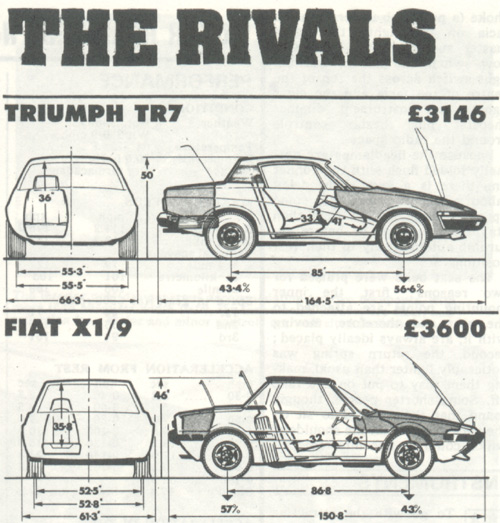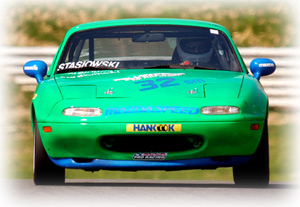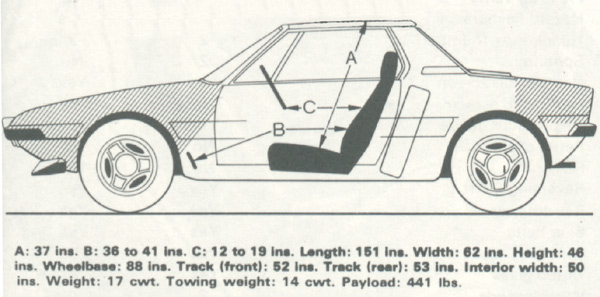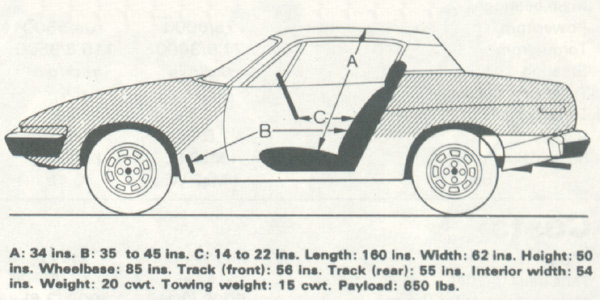|
Okay lets stress from the start that I've never been in a Fiat X1/9!!
Though I will confess to having been driven in a MX5 and also an MGB
GT, the latter I felt as if I'd just been promoted from a Rover 45 and
the former I felt very embarrassed at the though that people would think
I'm a hairdresser!!
The Fiat X1/9 was the most obvious car to compare to the Triumph TR7.
It’s true to say that there’s a similarity in the looks when
viewed from certain angles, and it helps see this resemblance if you
squint. Within the UK there’s a popular misconception that the
challenger from Blighty was the first on the scene…. Wrong - it
was the Fiat that came first. Prototypes of the X1/9 were around before
the close of the 1960’s and the vehicle was available from Italian
showrooms in 1972, large scale export commenced in 1974 and eventually
– following the emergence of our own 1970 motoring wedge - arrived
in RHD format for the UK in 1977.
Looking at the two cars you can see some similarity – there’s
 only
two seats in each for a start! And both have a rather pointy front end
and a stubby rear. The similarity really doesn’t extend much further
than that. The TR7 was much longer (over a foot) and much wider, though
the wheelbase on the Fiat was longer! only
two seats in each for a start! And both have a rather pointy front end
and a stubby rear. The similarity really doesn’t extend much further
than that. The TR7 was much longer (over a foot) and much wider, though
the wheelbase on the Fiat was longer!
But the Fiat X1/9 was not the only competitor! British Leyland, father
of the TR7, still built, and continued into the 80’s, the MGB GT
and the Roadster… one of the three vehicles (along with the TR6
and GT6) that the TR7 was designed to replace! More alarmingly the Japanese
had come onto the scene with the Datsun 280Z and then at the very dog-end
of the 70’s Mazda’s rather attractive RX7. However it was
with the Fiat that one can most obviously draw comparisons – though
the Fiat had a much longer lifespan, all told being available for some
10 years longer than the TR7, lasting another 7 years after the cessation
of the TR7/8 production. One wonders what may have happened had the
TR7/8 line development continued – as the Toyota MR2 started as
a project in 1976, before gaining momentum in 1979 (maybe sensing a
gap to be vacated by the Triumph?) and finally emerging in 1984 (1985
for the USA and UK). And then there’s the Mazda MX5 (Eunos, Miata),
though not emerging until 1989 the American ‘father’ of the
marque, Bob Hall, had already started initial designs at around the
time that the plug was pulled on the Triumph TR7. Taking the latter
scenario was something that the UK magazine 'Sports Car Classics'
 did
in November 2003 when comparing the revised Mazda MX5 against the Triumph
TR7 DHC! The reviewer’s opinion was quite surprising with a very
favourable report for the TR7. did
in November 2003 when comparing the revised Mazda MX5 against the Triumph
TR7 DHC! The reviewer’s opinion was quite surprising with a very
favourable report for the TR7.
Going back to the X1/9 and TR7 comparison…. Though built in the
same era the cars were technically very different – this may not
have been the case had the Austin-Morris (MG) design team had their
way with a replacement for the MGB GT; with the Morris team being a
bit more adventurous - and therefore costly. The "more
stylish" Fiat was a mid-engined 1.3l vehicle with brake
discs all around – ensuring a stopping distance of around 10m less
than the heavier TR7 from 60mph (now
do you want to think about upgrading your brakes?). On the styling
the Fiat scores over the original TR7 FHC by being available as a targa-top
- an option that was discarded too early by the British Leyland development
team… again on cost grounds. And, in an almost infamous test, the
X1/9 was picked as the prettier car by females at a pub in London!!
Bearing these factors in mind surely the X1/9 won hands down against
the Triumph TR7?
Not so.
In July 1977 'What Car?' did the most obvious thing and ran
a comparison test. They reported about the Fiat “this small,
well proportioned, mid-engined two seater has a striking appearance”
whereas “in many ways the TR7 is a disappointment…. What
emerged from the production line is no more than a Dolomite with controversial
styling”. Not a good start for our piece of 1970’s British
motoring heritage, though they do concede “the TR7 receives
as many admiring glances as the Fiat”
When it comes to performance the TR7 is helped by the SD1 5speed gearbox,
those with early FHC’s may be encumbered by the 4speed unit, which,
for some reason did not come with overdrive. 'What Car?' complains
“a sports car should be capable of cruising at 70mph without
the engine turning over at nearly 4000rpm”. Where both 4 and
5 speed variants do score well is the low-end torque which eliminates
the need for a lot of gear changing, the X1/9 will “thrive on
high revs, with 7000rpm possible without any apparent distress.”.
General consensus amongst the journalists of the time was that the X1/9
was "nippier"but the TR7 faster. What is interesting
is the comment in 'Sports Car Classics' (Nov 2003) on the TR7
that “the TR7 showed a clean pair of wheels to the opposition
over all the 20mph increments in high gears. In a top gear roll-on,
few cars of similar displacement would do better, even today. Or especially
today now that manufacturers use such high gears and engines tend to
be tuned for high revs.” I can certainly back up that quote
as the standard 2.0l lump has surprised a fair number of motorists with
a burst of speed… notably up the inclines.
The X1/9 “has no excessive body roll and
on smooth roads runs as though it is on rails….”
However it “takes time to get used to its sensitivity
to surface changes” whilst the TR7 “inspires
confidence from the start… responsive steering that makes
light work of controlling this car at whatever speed”
and they conclude that the TR7 “would take some beating
on a cross country journey” A few years later 'AutoCar'
in their edition for the weekending 15 March 1980 reported that
“...for steering lightness, the Fiat X1/9 comes out on
top. It is also accurate, though the car itself does not come
up to the TR7’s standards of directional stability.”

Virtually every journalist to test the TR7 has
commented
on the interior space and comfort and against the smaller
Fiat there really is no contest. The TR7 driver can be closer
to the pedals than the Fiat pilot and can also be up to 4inches
further away, and the same goes for the steering wheel where at
a maximum reach of 19inches you could feel somewhat cramped in
the Italian vehicle.

At the conclusion 'What Car?' (July 1977) say that the Fiat
X1/9 “is a fun car to drive whilst the sun is shining, and we
feel that prolonged ownership will be more demanding.” Whereas
the TR7 “does not have the aura of the X1/9, nor does it posses
the character of its predecessors.”
In all the TR7 comes out very favourably – 'Autocar' (15
March 1980) point out that it’s rival may be a little more nimble
and handle better, the TR7 offers the best compromise of comfort, performance
and handling. Meanwhile 'MotorWeek' for Sept 11 1976 finished
their report “…the TR7 is more comfortable and faster than
the more nimble Fiat.” And though they seemed to be going against
the TR7 ‘What Car?' signed off with “Given the choice
we would not hesitate to opt for the TR7, even if we still abhor its
exterior styling.”
|

